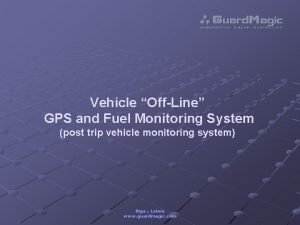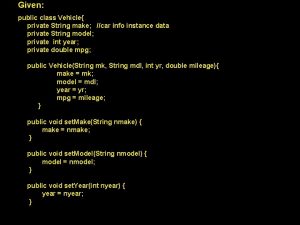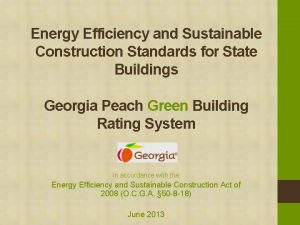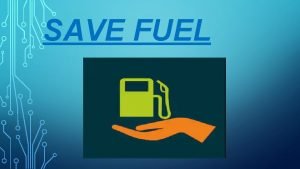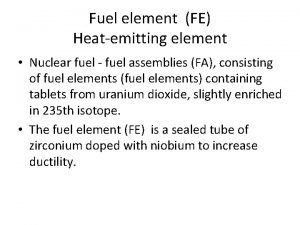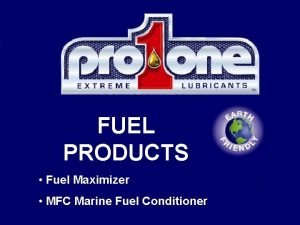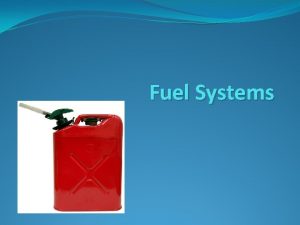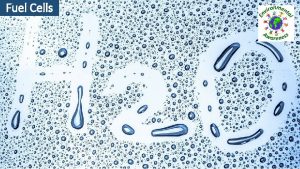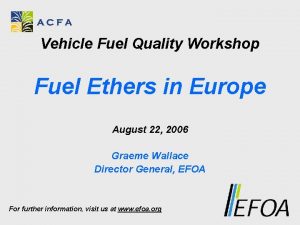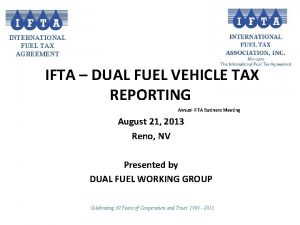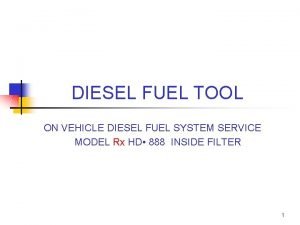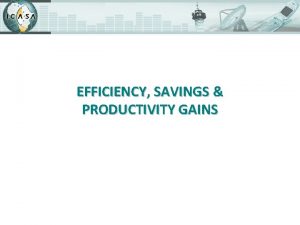Efficiency standards vehicle technologies and consumer fuel savings














- Slides: 14

Efficiency standards, vehicle technologies, and consumer fuel savings Nic Lutsey, Ph. D. March 20, 2014

Overview § § Automobile efficiency § Background, efficiency standards § Efficiency technologies § Impact on fuel costs Commercial freight truck efficiency § Background, efficiency standards § Efficiency technologies § Impact on fuel costs 2

Automobile fuel economy background § Average new vehicle fuel economy remained at 19 -22 mpg from 1980 -2009 § Horsepower has doubled since 1980, and vehicles have gotten heavier and larger § Vehicle technology has advanced, but not toward increased fuel economy § Fuel prices since 2011 have been twice as high as in the 1990 s and more unstable Adjusted label fuel economy from US EPA “Trends” report http: //www. epa. gov/otaq/fetrends. htm; US EIA fuel prices: http: //www. eia. gov/forecasts/steo/realprices/ 3

Automobile efficiency on the rise § California’s “Pavley” Assembly Bill 1493 of 2002 § § § Breaks decades-long stagnation creates standards for 2009 -2016 May 19, 2009: Agreement on 2012 -2016 standards (“ 35. 5 mpg”) July 29, 2011: Agreement for 2017 -2025 standards (“ 54. 5 mpg”) NY Times Bloomberg 4

Automobile efficiency on the rise § In 2004, California adopted the first greenhouse emission regulation, for light duty vehicles through model year 2016 § § Since, California and federal agencies collaborated on standards through 2025 Consumers will see fuel economy go from 19 to 38 miles per gallon (mpg) 39 mpg CAFE regulation 24 mpg Consumer fuel economy 19 mpg US EPA “Trends” report http: //www. epa. gov/otaq/fetrends. htm; US EPA/NHTSA 2012 -2016 and 2017 -2025 greenhouse gas emission and fuel economy standards: http: //www. epa. gov/otaq/climate/regs-light-duty. htm 5

Automobile efficiency: Technology § Light-duty vehicles have many energy losses (thermodynamic, accessory, friction, aerodynamic, tire, braking, etc) that can all be greatly reduced – for 4060% energy use and CO 2 reductions § Percent CO 2 and fuel consumption improvement for given technologies are shown § These technologies are all available in some variation in the marketplace today Engine • Engine friction reduction • Cylinder deactivation • Cam phasing • Variable valve lift • Turbo direct injection • Turbo cooled EGR 3 -4% 5 -6% 4 -5% 12 -15% 21 -24% Vehicle load reduction • Low-drag brakes • Electric power steering • Improved accessories • Tires • Aerodynamics • Lightweighting 1% 1% 2 -4% 2 -5% 5 -20% Hybridization • 12 V Stop-Start 5 -7% • High-voltage mild 6 -8% • Parallel hybrid 20 -35% Transmission • Torque convertor lock up • Aggressive shift logic • High efficiency gearbox • 6 -speed automatic • 8 -speed automatic • Dual clutch • Continuously variable 0 -1% 2% 3 -4% 2% 6 -8% 9 -13% 6 -10% 6 Sources: US EPA, NHTSA, CARB, 2011 -2012 regulatory assessments

Automobile efficiency: New models § Recent technology deployments are increasing fuel economy by 25 -50% § Engine, transmission, aerodynamic, lightweighting available across vehicle types § Hybrid technology goes further; electric vehicle technology goes much further Model CAFE (mpg) increase Label fuel economy (mpg) increase Fuel economy Technologies percent change 2012 Subaru Impreza 29. 3 40. 4 22 30 38% Continuously variable transm. , variable valve timing, 160 -lb mass red. 2014 Mazda 3 2. 0 L 35. 9 45. 9 27 34 28% Direct injection, 6 -speed auto. , 100 -lb mass reduction 2014 Mazda 3 2. 5 L 32. 7 43. 5 25 32 33% Direct injection, 6 -speed auto. , 100 -lb mass reduction, mild hybrid 2013 Volkswagen Jetta 31. 6 46. 2 25 34 46% Diesel, automated manual transmission 2014 Dodge Dart Aero 31. 9 43. 2 24 32 35% Turbo, variable valve lift, dual clutch transmission 2012 BMW 328 i 28. 5 36. 7 22 26 29% Turbo, direct injection, 8 -speed auto 2014 Bentley Continental 16. 2 23. 6 13 18 46% Direct injection, variable valve lift, cylinder deact. , 8 -speed 2013 Ford Explorer 20. 8 29. 8 16 23 43% Turbo, direct injection, 6 -speed automatic 2014 Range Rover 18. 5 24. 8 14 19 34% Supercharger, 8 -speed transm. , 700 -lb mass reduct. , stop-start 2014 Jeep Grand Cherokee 21. 7 31. 2 17 24 44% Diesel, 8 -speed automatic, aerodynamics 2013 GMC K 15 Sierra 15 19 28% Direct injection, cylinder deactivation, 6 -speed automatic 19. 0 24. 4 Source: Model year 2010 -2014 vehicle fuel economy testing; from US EPA fuel economy guide data file: https: //www. fueleconomy. gov/feg/download. shtml 7

Efficiency technologies: Driving costs down § Due to increased fuel economy standards, new vehicles will see a reduction in fuel consumption by over 40% from 2012 to 2025 § § Per-mile fuel costs reduced from $0. 16 $0. 09 per mile Annual per-vehicle fuel bill are reduced from $1, 900 $1, 100 per year 21 mpg 24 mpg 38 mpg US EPA “Trends” report http: //www. epa. gov/otaq/fetrends. htm; US EPA and NHTSA 2012 -2016 and 2017 -2025 greenhouse gas emission and fuel economy standards: http: //www. epa. gov/otaq/climate/regs-light-duty. htm; US EIA fuel prices: http: //www. eia. gov/forecasts/steo/realprices/ 8

Electric-drive: Much lower annual driving costs § Shifting from average gasoline vehicle to an electric vehicle goes much further in reducing annual vehicle energy costs: § § At $0. 20 per k. Wh, drops annual average fuel bill by over 50% At $0. 10 per k. Wh, drops annual average fuel bill by over 75% 21 mpg 24 mpg 38 mpg Electric vehicle @ $0. 20/k. Wh Electric vehicle @ $0. 10/k. Wh US EPA “Trends” report http: //www. epa. gov/otaq/fetrends. htm; US EPA and NHTSA 2012 -2016 and 2017 -2025 greenhouse gas emission and fuel economy standards: http: //www. epa. gov/otaq/climate/regs-light-duty. htm; US EIA fuel prices: http: //www. eia. gov/forecasts/steo/realprices/; Electric vehicle based on 0. 34 k. Wh/mile 9

Truck efficiency on the rise, too § § § Industry and fleet efforts, US EPA Smart. Way program, and California greenhouse gas tractor-trailer rule have led the push for increased efficiency May 21, 2010: First truck efficiency standards (“Phase 1”) Feb. 18, 2014: Announcement of next phase of standards (“Phase 2”) 10

Truck efficiency: Technology § Heavy-duty vehicles have many energy losses (thermodynamic, accessory, friction, aerodynamic, tire, etc) that can all be greatly reduced – for total of 3045% energy use reduction. § Percent CO 2 and fuel consumption improvement for given technologies are shown Tractor • Tires: 1 -3% • Aerodynamics: 2 -4% • Engine idle-off: 5 -6% • Lightweighting: 2% Engine • Friction, load reduction: 1 -2% • Aftertreatment: 1 -3% • Advanced control, injection: 1 -3% • Turbo, air handling: 1 -2% • Turbocompounding: 2 -5% • Waste heat recovery: 4 -8% Transmission • Direct drive: 1% • Single drive: 1 -2% • Friction reduction: 1 -2% • Automated manual: 2 -8% • Dual clutch: 2 -10% Trailer • Tires/wheels: 1 -6% • Aero skirt: 3 -5% • Aero gap: 1 -3% • Aero tail: 3 -5% • Lightweighting: 2 -5% Sources: EPA, 2011; NRC, 2010; TIAX, 2012; ICCT, 2013 (http: //www. theicct. org/trailer-technologies-increased-hdv-efficiency, http: //www. theicct. org/ghg-reduction-potential-heavy-duty-vehicles-eu) 11

Truck efficiency: Cost reductions § Due to increased efficiency standards, new Class 8 tractor-trailers could see a reduction fuel consumption by up to 40% § Tractor-trailer efficiency could increase from 6 mpg ~10 mile per gallon § Per-ton-mile freight fuel costs reduced from $0. 36 $0. 20 per ton-mile Based on US EIA Annual Energy Outlook (diesel prices), Transportation Energy Data Book (historical vehicle fuel economy); US EPA/NHTSA 2014 -2018 rulemaking, assuming 38, 000 lb payload for high-roof sleeper cab Class 8 tractor-trailer 12

Conclusions § Great potential for increasing the efficiency in the transportation sector with cost-effective emerging technologies § § Efficiency improvements are on the way due to new light-duty efficiency (and greenhouse gas emission) standards through 2025 § § Advanced engines, transmissions, aerodynamics, lightweighting, etc Consumers will save ~40% on per-mile and annual fuel costs Efficiency improvements are on the way, due to new heavy-duty efficiency (and greenhouse gas emission) standards in 2025+ timeframe § Shippers, retailers, (and indirectly consumers…) could save up to ~40% on per-ton-mile shipping costs Based on US EIA Annual Energy Outlook, Transportation Energy Data Book; US EPA/NHTSA 2014 -2018 rulemaking, assuming 38, 000 lb payload for high-roof sleeper cab Class 8 tractor-trailer 13

Thanks! nic@theicct. org 14
 Secondary consumer in food chain
Secondary consumer in food chain Productive inefficiency and allocative inefficiency
Productive inefficiency and allocative inefficiency Vehicle fuel monitoring system
Vehicle fuel monitoring system Productively efficient vs allocatively efficient
Productively efficient vs allocatively efficient Productively efficient vs allocatively efficient
Productively efficient vs allocatively efficient Public class vehicle private string name protected vehicle
Public class vehicle private string name protected vehicle Conclusion of brake system
Conclusion of brake system Chapter 5 consumer markets and buyer behavior
Chapter 5 consumer markets and buyer behavior Consumer markets and consumer buyer behavior
Consumer markets and consumer buyer behavior Georgia energy efficiency standards
Georgia energy efficiency standards Desert herbivores
Desert herbivores Cengage
Cengage Consumer research process
Consumer research process Canada motor vehicle safety regulations
Canada motor vehicle safety regulations Factors determining service standards
Factors determining service standards


